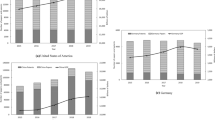Abstract
Conventional monitoring technologies have the limitation to monitor because the extensive arrangement of the sensing system has caused many problems such as the increase of costs, difficult in arrangement, inconvenient maintenance, massive amounts of data, etc. To overcome this limitation, it is necessary to obtain new monitoring technology which is able to quickly analyze crane structure and its vulnerable area (or weakest link), and take the reasonable arrangement to sensing system. Therefore in this paper, we proposed the vulnerability analysis method and implementation of crane health monitoring based on vulnerability theory and methodology, such as the importance and redundancy coefficient, determination of failure mode and search of failure path, indeterminacy of static and kinematic, strain energy and flow potential, etc. Also we evaluated the effectiveness of our proposed method through the numerical example.



Similar content being viewed by others
References
Wen, H., Qin, Y.X., Qian, Y.: Lifting Appliances. China Machine Press, Beijing (2013)
Wang, S.Q., Wen, H.: Safety Protection Technology of Cranes. China Railway Publishing House, Beijing (2009)
Wang, F.M.: Accident Prevention and Failure Analysis of Cranes. Beijing Institute of Technology Press, Beijing (2008)
Zhang, S.B., Shi, J., Fei, X.T.: Current status of crane health monitoring. Constr. Mach. 6, 65–70 (2016)
Ding, K.Q., Wang, Z.J., Zhao, N., et al.: Research progress on structural health monitoring technology for large crane. Hoisting Convey. Mach. 8, 1–4 (2012)
Pei, W., Ding, K.Q., Wu, D.J.: Method of safety health monitoring and damage alarming for cranes. Mech. Eng. Autom. 6, 120–122 (2010)
Li, N., Yang, B., Jiang, S.F.: Vulnerability analysis based on important factors of members. J. Liaoning Tech Univ. 29(1), 83–86 (2010)
Liu, C.M., Liu, X.L.: Stiffness-based evaluation of component importance and its relationship with redundancy. J. Shanghai Jiaotong Univ. 39(5), 746–750 (2005)
Bai, W.T.: Study on Two Key Problems in Seismic Design and the Seismic Fragility of Factory Building Structures in Nuclear Power Plant. Institute of Engineering Mechanics, China Earthquake Administration, Harbin (2013)
Li, H.N., Li, D.S.: Safety assessment, health monitoring and damage diagnosis for structures in civil engineering. Public Commun. Sci. Technol. 22(3), 82–90 (2002)
Xie, Q., Xue, S.T.: Research state and advances on structural health monitoring in civil engineering. Bull. Natl. Nat. Sci. Found. China 15(5), 285–288 (2001)
Pei, Q., Guo, X., Zhang, M.Z.: A review of health monitoring and damage detection of bridge structures. J. Earthq. Eng. Eng. Vib. 23(2), 61–67 (2003)
Xiong, H.B., Li, Z.Q.: State of the art of structural health monitoring. Struct. Eng. 22(5), 86–90 (2006)
Zhou, J.Y., Chen, W.J., Du, B., et al.: Analysis of distributed static and kinematic indeterminacy of pre-tensioning cable-strut systems. J. Shanghai Jiaotong Univ. 50(3), 345–350 (2016)
Xu, N.: Vulnerability Analysis of Frame Structures Based on Flow Potential. Shanghai Jiao Tong University, Shangha (2014)
Xu, N., Zhang, L.M.: Vulnerability of frame structures based on flow potential. Sichuan Build. Sci. 1, 109–112 (2015)
Xu, G.N.: Metal Structure Design of Mechanical Equipment, 2nd edn. China Machine Press, Beijing (2011)
Jiang, S.F.: Introduction to Structural Health Monitoring. China science Press, Beijing (2013)
Wu, Z.H., Zhang, J.: Advanced Structural Health Monitoring Technology and Theory. China science Press, Beijing (2013)
Dai, Bq, Wang, C.G., Fu, Y.K.: Materials Mechanics Course. Beihang University Press, Beijing (2004)
Li, L.K.: Structural Mechanics. Higher Education Press, Beijing (2004)
GB/T706—2008, Hot-Rolled Steel Section. Standards Press of China, Beijing (2008)
ISO 630:1995, Structural Steels—Plates, Wide Flats, Bars, Sections and Profiles, NEQ
Zhang, L.Y.: Research of On-line Life Prediction System for Large Crane. Dalian University of Technology, Dalian (2009)
ASME NOG-1-2004, Rules for construction of overhead and gantry cranes (top running bridge, multiple girder)
Acknowledgements
Supported by the Applied Basic Research Programs of Shanxi Province (Natural Science Foundation) (Grant No. 201601D102034).
Author information
Authors and Affiliations
Corresponding authors
Rights and permissions
About this article
Cite this article
Quan-wei, W., Ge-ning, X. & Hao, W. Research on health monitoring and sensing technology based on vulnerability analysis. Cluster Comput 22 (Suppl 3), 5323–5332 (2019). https://doi.org/10.1007/s10586-017-1229-1
Received:
Revised:
Accepted:
Published:
Issue Date:
DOI: https://doi.org/10.1007/s10586-017-1229-1




